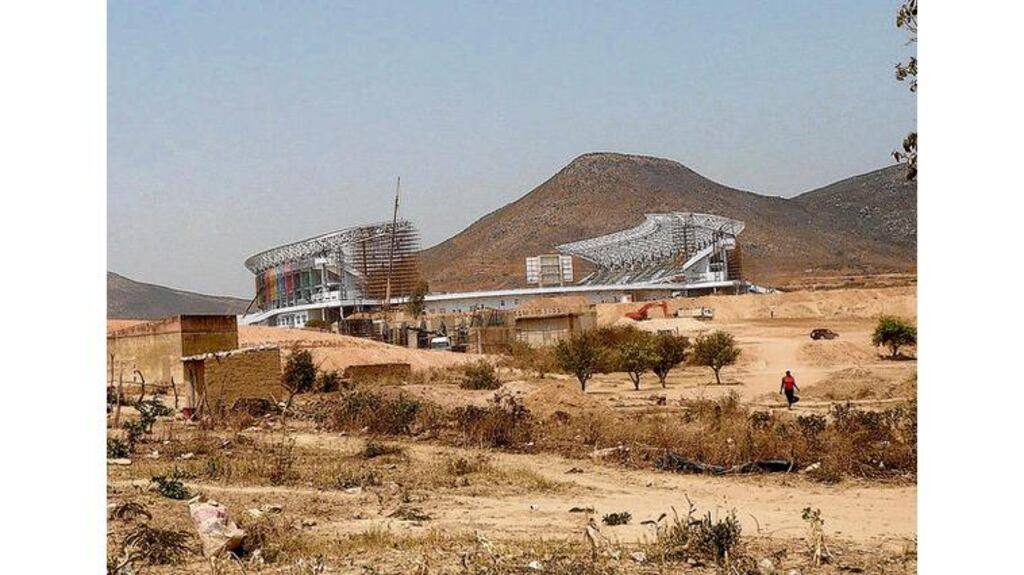SOCCER: AFRICAN CUP OF NATIONS: MATT SPIROon the vast millions spent on stadiums by a country where most people survive on 70 cent a day
THE 27TH Africa Cup of Nations begins in Angola tomorrow with the hosts taking on Mali in their glitzy new national stadium in the capital, Luanda. For a country that has been ravaged by civil war in modern times, the festive, colourful and peaceful scenes that are sure to accompany tomorrow’s opening ceremony could be seen to symbolise a new dawn for Angola.
From the moment their Nations Cup bid was accepted, the Angolan authorities have looked at this high-profile event as an ideal opportunity to showcase the country’s changing image and new-found wealth. Huge efforts have been made not only to ensure a safe and successful tournament but also to promote the oil-rich country as an emerging economic power.
Indeed, more than €700 million has been spent improving infrastructure with the construction of two new airports, a series of road networks, hotels and, above all, four new stadiums. The Palancas Negras, or the Black Antelopes as the Angola team is known, will play their games in the state-of-the-art 11 de Novembro Stadium, which seats 50,000 and cost €140 million.
There is a good chance the stadium will be full and the atmosphere vibrant tomorrow. Although tickets have only just gone on sale, some 25,000 volunteer “fans” have been assembled by the Local Organising Committee (LOC), having even held rehearsals to fine-tune their singing and dancing.
Billboards proclaiming Angola as “Africa’s fastest growing economy” are visible in the stadium and around the town, and the intended message is clear: Angola is no longer a war zone but a nation thriving economically and an ideal place in which to invest. “We want to show people Angola is a nice country, that the war is over and we are united,” said LOC director Antonio Mangueira. “It’s an opportunity for us to recover our pride.”
Sadly, however, there are two distinctly different faces to modern-day Angola.
The one television viewers will see over the next three weeks is of lavish wealth. The southern nation possesses the continent’s third largest oil reserve and will soon be the world’s leading exporter of diamonds. In 2009, Luanda officially became the world’s most expensive city, overtaking Tokyo. Angola is flushed with money but only a small minority of the population – and mainly expatriates – see any of it.
Over 70 per cent of the population live below the poverty threshold, surviving on less than 70 cent a day. Much of the country’s infrastructure was destroyed during 27 years of fighting which ended in 2002, leaving behind tens of thousands of refugees and rendering much of the country impassable due to unexploded landmines.
Under such circumstances, is it possible to justify an outlay of €420 million on building four stadiums that will scarcely even be used after the tournament? From above, the arenas look like terrible anomalies, space ships that have landed in shanty towns. Most of the population would prefer to have access to clean water.
Angola cannot even argue the construction work has created jobs at home as the labour has essentially been carried out by the Chinese, whose appetite for building sporting venues in Africa shows no sign of diminishing. The Shanghai Urban Construction Group, responsible for erecting two superb yet equally inappropriate stadiums for the tournament in Ghana two years ago, secured the bulk of the contracts again and have employed as many as 100,000 Chinese labourers.
China is launching similarly ambitious plans in 20 other African countries with the intention of strengthening their political and economic clout in the continent. The Asian powerhouse has already established itself as the principal purchaser of Angola’s oil, accounting for 13 per cent of exports.
If Chinese builders and the Angolan government are happy, it is much harder to see how this tournament might benefit the local people. The one clear positive observation is for once Angola will be in the international news for a reason other than war, disease and poverty.
Soccer remains the number one passion in Africa and offers many under-privileged people an opportunity to escape from the difficulties of everyday life. For many Angolans, this tournament will be a welcome distraction. Soon after the civil war ended in Angola, the Palancas Negras emerged as a great and unexpected source of national pride under the canny coaching of native Luis Goncalves.
Goncalves, who was in charge from 2003 to 2008, pieced together a competitive side by drafting in a handful of Angolan emigrants who were playing in Portugal and integrating them with the most gifted local talents.
“Getting people interested in soccer in a country where survival is the main objective has not been easy,” Goncalves said after qualifying Angola for the 2006 World Cup at Nigeria’s expense and against all the odds.
Back then, the presence of Benfica forward Pedro Mantorras symbolised the Angolan miracle. Mantorras lost both his parents to the war and raised his three siblings alone. The man once described as the best player from Portuguese-speaking Africa since Eusebio has struggled with injury in recent years but is part of the squad again at this tournament.
Angola’s soccer fortunes, however, have been on the decline since Goncalves resigned. They have dropped to 95th in the Fifa rankings and would not have qualified for this year’s Nations Cup had they not been hosts. Realistically, the home fans are unlikely to have much to cheer in the coming weeks, despite Angola being handed a kind draw in Group A. Manuel Jose’s men should see off Malawi, and stand a small chance against both Mali and Algeria, particularly as the North Africans will have one eye on next summer’s World Cup. But another quarter-final berth is probably the best they can hope for.
The five World Cup qualifiers present – Algeria, Ivory Coast, Ghana, Nigeria and Cameroon – start as the obvious frontrunners, although there is a feeling they will treat the tournament as little more than a fine-tuning exercise before the main event in South Africa.
Ghana, the only African side to reach the last 16 at the 2006 World Cup, should be among the favourites, yet coach Milovan Rajevac is being extremely cautious with his leading players. Premier League defenders John Pantsil (Fulham) and John Mensah (Sunderland) have been omitted due to injuries, captain Stephen Appiah is also absent, while Chelsea’s Michael Essien could sit out the group stage as he returns steadily to full fitness.
Didier Drogba’s Ivory Coast are the team to beat and they should be more focused than many of their rivals given they have not won the trophy since 1992. The Elephants have been beaten by Egypt in the latter stages of the last two tournaments, but the reigning African champions now appear on the decline. They missed out on the World Cup to Algeria, and could struggle is survive in Group C along with the South Africa-bound Nigerians, Mozambique and Benin.
A resurgent Cameroon should dominate Group D, although their star names are already thinking about the bigger prize. “When I look at our squad I can’t help but think we can prevail in South Africa,” said striker Samuel Eto’o this week.
“We’re not in any way inferior to the Brazilians, Argentines, Spanish or French.”
Before Eto’o and friends take on the world, the Indomitable Lions must negotiate their way past Tunisia, Gabon and Zambia.
With the World Cup taking place on African soil for the first time, it is understandable those qualified countries prioritise the summer tournament. It does, however, raise the question of whether the Nations Cup really has its place in a World Cup year.
Scheduling the tournament in winter continues to anger European clubs who lose players mid-season, yet this is necessary in order to avoid rainy seasons and extreme temperatures in Africa. Altering the frequency of the tournament is a more pertinent discussion. If, for example, it took place every four years rather than two, anticipation levels would increase and the strain on African players – most of whom endure long seasons with their clubs in Europe – would be relieved.
Last year witnessed the inaugural African Nations Championship (CHAN), an international competition set up for domestic-based players only. This commendable initiative adds credibility to Africa’s domestic leagues and offers home-based players the opportunity to gain international experience. Why not stage the CHAN during World Cup years and the Nations Cup in the same years as the European Championship?
The main reason this will not happen any time soon is money. Thanks to lucrative sponsorship and television deals, the Nations Cup constitutes a vital source of revenue for African soccer’s governing body. It could also be argued that staging the competition every two years hands more nations the possibility of reaping the benefits that come with being hosts. There is certainly potential for the country to attract outside investment, as Angola hope to show. But the benefits that will accrue to the country’s less well off are less obvious.
Angola - The Facts:
Population:18.5 million.
Independence:Angola gained independence from Portugal in 1975
President:Jose Eduardo dos Santos has led Angola since 1979.
Politics:The ruling Popular Movement for the Liberation of Angola (MPLA) and rebel group Unita have been at loggerheads since the 1970s, when the former was supported by the Soviet Union and the latter by the US.
Civil war:In 2002, the death of Unita leader Jonas Savimbi brought 27 years of fighting to an end, although there is still unrest in the oil-rich Cabinda province.
Life expectancy:45 years (men), 49 years (women).
Major languages:Portuguese (official), Umbundu, Kimbundu, Kikongo.
Major religion:Christianity.
Main exports:Oil, diamonds, minerals, coffee, fish, timber.
Economy:Angola boasted the second fastest growing economy in the world last year behind Qatar.
Area:1.25m sq km (481,354 sq miles).











